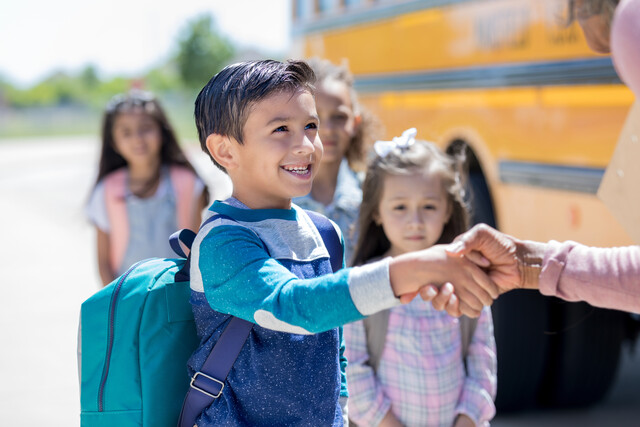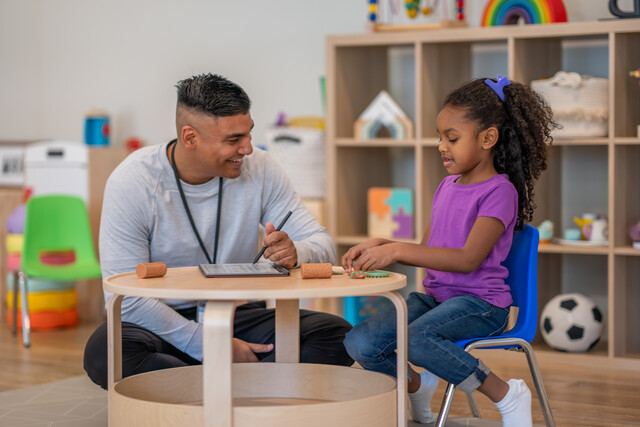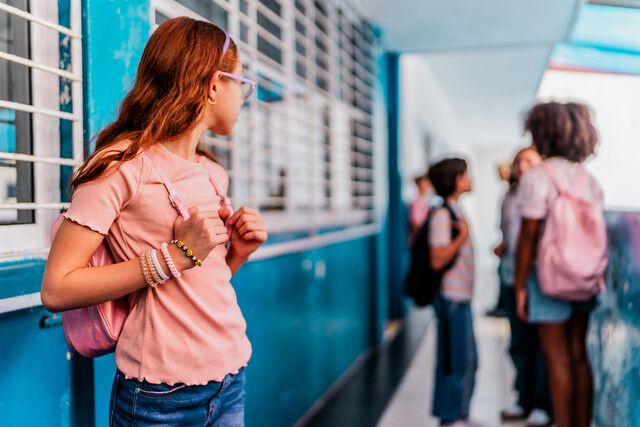When we send our children to school around the nation, we tend to believe they are going to be safe. At the middle school level they should be making their way through a variety of subjects as they learn to navigate the halls and change classes every hour. When they reach high school they begin to search for the answers of who they are, and what their future holds. They will begin exploring more subjects that personally interest them. Many will engage in some type of school spirit campaign that will bring them joy, as well as lasting memories.
What we don't expect to happen is for our middle and high school students to head off to school each day and be ridiculed, teased, intimidated, excluded, or physically harmed. Not many parents would get their kids up each morning and send them off to school for a day of such abuse. Unfortunately, for millions of children around the nation, that's what is happening on a daily basis. What's even more unfortunate for parents of special needs children is that they are at an even higher risk for becoming a victim to bullying.
Creating More Challenges
According to the Centers for Disease Control and Prevention (CDC), one out of every 88 children in America is now believed to have autism, a developmental disability. When a child has autism, the brain processes information differently and the results of that can range from speech delays, to social and communication issues. Many of these students are being placed into mainstream classrooms, which may be ideal for their learning situation. However, it may not be so great when it comes to the issue of bullying.
Research conducted by Johns Hopkins University found that around 63 percent of students with autism have been bullied. Other research has demonstrated similar findings, indicating children with autism and other, similar conditions, are bullied 50 percent of the time. Turns out, children with any type of developmental disability or challenge are four times more likely to be the victim of a bully. Many of the students with these challenges are considered "high functioning," so they are placed into mainstream classes, and right into the path of bullies who are looking for an easy target. Unfortunately, bullies find peers with any form of challenge to be weak, making it easier for them to exert power over them.
Students with autism and other such challenges, may have a more difficult time standing up for themselves or not appearing weak to the bully. They are more likely to need others around them to come to their defense, or to know the proper channels to get help for the bullying.
Some of the things that can be done include:
- Have teachers work such issues into their curriculum. Children who have empathy for others are more likely to not engage in bullying, as well as stand up for those they see being bullied.
- Make sure parents, students, and teachers, are aware of the disability harassment issues and know the proper channels for reporting it if they see it take place.
- Those students who do have disabilities need to know they can get help, and how to go about doing it. They need to have a trusted method for reporting the information, without the fear of retaliation.
- Schools need to create programs to monitor the environment to ensure those with disabilities are not being harassed. They also need to follow up with any issues that do arise, to make sure they have been properly resolved.
- It is also important for schools to assess their policies regularly so they can see how effective they are, and if they need to be adjusted.
- Parents need to know to watch for bullying, to help monitor the situation, and they need to know how to go about addressing the issue if their child is being bullied.
- Peer awareness and advocacy is going to be important to address this situation. Peers need to be taught to step up to the plate to help those in need. Chances are, they all have a family member -- a cousin, a sibling, etc.-- who has a challenge, and they wouldn't want that person being treated in such a manner.
While many students go to one school, they tend to become places of exclusion and break people up into groups. It doesn't take long for students to find out who has what challenges and to exclude them from their group. It's important for schools to change attitudes, hearts and minds, and place an emphasis more on what people have in common, so they are not focusing on those things that are different.
Whether a student has autism, attention deficit hyperactivity disorder, cerebral palsy, or another challenge, fellow students need to learn to focus on what they have in common with those children, rather than what separates them. Empathy is the ability to understand how another person will feel. We may not all have autism, but we all know what it feels like to be excluded, teased, or ridiculed. Increasing empathy in middle and high school students is essential to not only ending teasing, but getting students to be more caring about their fellow classmates, challenges or not.
To increase empathy in schools, teachers can work on incorporating curriculum that covers understanding feelings, emotions, and finding similarities between people. Basically, the more we can teach our youth to put themselves in the challenged person's shoes, and understand what they may go through being bullied, the more successful we will be at tackling the issue.
The facts surrounding the bullying issue in America have gotten out of hand. They have become alarming and are prompting people around the country to sit up, take notice, and spend time deciding where we go from here. It's clear that something needs to be done. As parents, we cannot keep sending our children to school fearing that they will be bullied, possibly to the point that they will either quit school or worse, they may commit suicide as so many have already done.
The Reach of the Problem
While we have looked at a variety of ways that teens are bullied today, we haven't yet discussed bullying that takes place by adults. The reason this is so important is because bullying is often a learned behavior. Many children who bully have learned the behavior by living in a home that has a bully. Perhaps the child has a parent or sibling that bullies them, thus teaching them it is acceptable behavior. Additionally, and while we may not like to think of it happening, there are even teachers who get bullied, as well as do the bullying.
Take, for example, an incident that took place at Gig Harbor Middle School in Washington. A middle school student was videotaped being harassed in the classroom for a period of 15 minutes. During that time, the video showed that the boy was dragged around the classroom, written on, buried under chairs, and had his socks stuffed into his mouth. One of the most disturbing parts of the cell phone video footage from the ordeal was that the teacher actually took part in the bullying. The math teacher was believed to have led the bullying and poked the boy and joked about what was transpiring. Ultimately the teacher was suspended for 10 days, was moved to a new middle school, and was given training on classroom management.
There are also incidents of teachers being bullied by their middle and high school students. In Pittsburgh, Jim Addlespurger finished up his day teaching English and headed out of the school. On his way out he was blindsided by a group of teens and punched hard enough that he was knocked unconscious. Little did the teens know that the incident was caught on surveillance video. Days later the student, who actually attended a different school than the victim, was identified and arrested.
The problems associated with bullying are well documented. The research is there to also back it up. The National Center for Educational Statistics reports that:
- There is more bullying that takes place at the middle school level than at the high school level.
- The most common type of bullying involves exclusion, pushing, shoving, tripping, and spitting.
- Cyberbullying is the most common type of bullying for those in tenth through twelfth grade.
- Most bullying takes place at school, or on the way to it, including on the school bus.
- The group that most often sustains injuries from bullying are thosein the sixth grade. The percentage of those sustaining injuries from bullying peaks in this year and then slowly declines each year after that.
- Even years after bullying takes place, victims can still suffer from a lack of self-esteem, not being able to trust people, not being assertive, exhibiting aggression and isolation.
Bullying during the middle and high school years is an important issue because it is a vulnerable time for these students. They are at a point in their life when they are striving to make friends, be accepted, and define who they are, and who they will become. Those around a student will help to shape that, for better or worse. Bullies can have a profound and lasting impact on these students.
Creating Change
As we go through life, we often think of the many things that need to be done to make the world a better place. We think that "someone" needs to do something. When it comes to this issue, like so many others, that "someone" needs to start with you. Like Gandhi said, we have to be the change we wish to see in the world. The bullying prevention movement needs people around the country to step up, get involved, and make positive change.
Peer Advocacy
We have already learned about the important role that peers can make in the lives of middle and high school students. They can impact their lives negatively, especially when bullying takes place. But they can also have a positive impact. One of the most effective ways to help prevent and stop bullying is to create a peer advocacy group at every school.
What it Is and Why it Works
Peer advocacy is the act of one student speaking up for another. In other words, if they see bullying taking place they step up and help bring it to a stop. The bully perceives the victim as being weak, but when someone stands up for the person, that thought diminishes. Many schools are beginning to explore the idea of having a peer advocacy group to tackle this important issue.
Peer advocacy groups work so well because it's a peer-on-peer dynamic, rather than adults stepping in. Plus, students tend to see more of the bullying that takes place than do the adults. When a student stands up for someone, or tells someone to stop their bullying, they are much more likely to listen to them. Creating a peer advocacy group is especially important when it comes to students with disabilities or other challenges. If you have a group of students who is willing to stand up on others' behalf, you can help make the school a safer environment for everyone.
To create a peer advocacy group at a middle or high school, consider these points:
- Recruit students, staff, and parents who want to become part of the peer advocacy group. Let them know what it will involve so they go into it wanting to help make their school a safer environment.
- Inform the parents that a peer advocacy group has been formed, and what its function and goal is.
- Help those in the group identify the students who need help the most. Again, you will want to make sure they know who the special needs students are so they can provide them with the assistance they may need.
- Provide the group with training so they know who they are advocating for, how to advocate, and what type of reporting process there is. If they will be advocating for a specific peer who has special needs, be sure that they know what their challenge is, and what the characteristics of it are. For example, if they will be advocating for someone who is autistic, they should know what autism is and what the main characteristics are that the student they are advocating for has.
- Hold regular peer advocacy meetings. At these meetings issues can be discussed, they can do team- building exercises, get to know one another, learn more, etc.
- Make sure that parents and school staff continue to provide the peer advocacy group with any support it may need to help make the program successful.
Similar to creating a peer advocacy group, there are other teen options that can provide successful results to help curb bullying. Teen court, where bullies will have to go before their peers in a court-like setting, can be effective. Throughout the state of California, there are more than 70 high schools that engage in having a teen court. They have trained students who will question, determine guilt, and recommend a sentence for those students who find their way there, whether from bullying or for other issues.
Other options include peer mediation, which is similar to teen court, where designated mediators would step into the situation and try to help diffuse the situation. It's important that in combating bullying the students, themselves, be empowered to make their school safer. You are only limited to your imagination when it comes to finding ways to help raise awareness and bring an end to bullying.
There are plenty of teens out there who also want to take back their schools and make them safer. Take, for example, Ashley Craig, a middle school student who was told by a fellow classmate that he was going to commit suicide. She immediately told a guidance counselor and he received help. Once he went back and told her later that she had saved his life, she decided that she wanted to also help save others. So she started an anti-bullying program at her school.
The most effective anti-bullying measures that can be taken are the ones that are going to empower the students to make their school a safer place. Programs such as teen advocacy and teen court, along with educating the students to stand up for fellow classmates, will do more to prevent, and end bullying, than anything else.


























